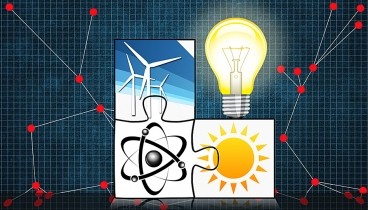Many efforts to smooth out the variability of renewable energy sources — such as wind and solar power — have focused on batteries, which could fill gaps lasting hours or days.
But MIT’s Charles Forsberg has come up with a much more ambitious idea: He proposes marrying a nuclear powerplant with another energy system, which he argues could add up to much more than the sum of its parts. Forsberg, a research scientist in MIT’s Department of Nuclear Science and Engineering, describes the proposals in a paper published in the November issue of the journal Energy Policy.
Now may be just the time for such new approaches, Forsberg says. “As long as you had inexpensive fossil fuels available for electricity demand, there was no reason to think about it,” he says. But now, with the need to address climate change, curb greenhouse gas emissions, and secure greater energy independence, creative new ideas are at a premium.
While nuclear plants are good at producing steady power at relatively low cost, their output cannot rapidly be ramped up and down. Meanwhile, renewable energy sources are also good at producing power at low operating cost, but their output is unpredictable. Fossil fuel plants can easily be switched on or off as needed, but have higher operating costs and produce greenhouse gas emissions.
One solution, Forsberg suggests, is to find a way to divert excess power from a nuclear plant, making it a “dispatchable” source of electricity — one that can easily be ramped up and down to balance the disparities between production and demand.
But what to do with that diverted power?
The paper outlines three concepts, which Forsberg says could have potential in the coming decades. They involve pairing a nuclear plant with an artificial geothermal storage system, a hydrogen production plant, or a shale-oil recovery operation.
The last of these ideas would locate a nuclear plant near a deposit of oil shale — a type of deposit, technically known as kerogen, that has not been used to date as a source of petroleum. Heated steam from a nuclear plant, in enclosed pipes, heats the shale; the resulting oil can be pumped out by conventional means.
At first glance, that might sound like a “dirty” solution, enabling the use of more carbon-emitting fuel. But Forsberg suggests that it’s quite the opposite: “When you heat it up, it decomposes into a very nice light crude oil, and natural gas, and char,” he explains. The char — the tarlike residue that needs to be refined out from heavy crude oils — stays underground, he says.
Today, the heating of the rock is usually accomplished by burning fossil fuels, making the process less efficient. That’s where the excess heat from a nuclear plant comes in: By coupling the plant’s steam output with a shale-oil well, the oil can be recovered without generating extra emissions. The process also does not need regular heat input: The nuclear plant can operate at a steady rate, providing electricity to the grid when needed, and heating oil shale at times of low electricity demand. This enables the nuclear plant to replace the burning of fossil fuels in producing electricity, further reducing the release of greenhouse gas.
The world’s largest oil-shale deposits are concentrated in the western United States. “We lucked out,” Forsberg says. “This has the lowest carbon footprint of any source of liquid fossil fuel.”
The resource that could be unlocked is enormous, he says: “Some of these deposits would yield a million barrels per acre. There’s no place else on Earth like it.”
Steven Aumeier, director of the Center for Advanced Energy Studies at the Idaho National Laboratory, says, “Many times the most formative game-changing approaches are not single new technologies, but rather novel ways of combining technologies. Hybrid energy systems could be a game-changing approach in enabling the cost-effective, secure, and high penetration of low-carbon energy into the economy.” Aumeier adds that such systems would “afford a practical and regionally scalable means of using an ‘all of the above’ approach to energy security.”
Funding for the research was provided by the U.S. Department of Energy, the Idaho National Laboratory Institute for Nuclear Energy Science and Technology, and the French nuclear company Areva.



Swiss are already doing it – buy cheap night nuclear electricity from Germany, pump water up in the artificial lake, drain it in the morning and sell it as “blue” energy on the internal market.